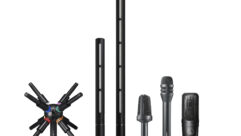
Audio and Light: Install at St. Pius, Part 1
May 12, 2011 10:07 AM,
with Bennett Liles
Listen to the Podcasts
|
Editor’s note: For your convenience, this transcription of the podcast includes timestamps. If you are listening to the podcast and reading its accompanying transcription, you can use the timestamps to jump to any part of the audio podcast by simply dragging the slider on the podcast to the time indicated in the transcription.
You’ve got a big brand-new church with a huge open space, hard walls, and lots of long reverb time, so how do you make it sound right for speech and live music? Brian Cox is here from Audio and Light in Greensboro, N. C. to tell us how he made it happen for St. Pius Tenth Parish, coming up on the SVC Podcast.
Brian, it’s great to have you with me on the SVC podcast from Audio and Light in Greensboro, N. C. and you did a big audio system in the new sanctuary of St. Pius Church there and that’s always a challenge with more traditional church designs not being known for being very acoustically friendly. First though, tell me a little bit about Audio and Light and what sort of clientele does the company have and how long’s Audio and Light been around?
We’ve been around actually since 1984—27 years. The original owners started the business as a live production house, which we still do. We still have a very large live production department. We do walk-in rentals but our main business has gravitated to systems integration and design over the past ten years or so. [Timestamp: 1:29]
Well that’s a very competitive field.
It is and we really try to focus on the house-of-worship market, higher education and corporate…and a little bit of government work. We stay out of K-12 and some of the other things, but those are our main focuses. [Timestamp: 1:44]
And this church, St. Pius Tenth Parish, describe this one for me. They’ve got a big congregation of over a thousand now, and this was a brand-new and bigger church for them. I guess they had been holding separate services because of the limited space in their old building and this new one was a way to get everyone there at the same time?
Exactly. The previous church building was built in the 70’s and seated about 350 and they were holding multiple masses every weekend and have somewhere in the neighborhood of 7-900 in attendance over the weekends. So they were really busting at the seams as far as their whole ministry there, and so this new facility that they’ve just completed will seat 1,100 so they can have pretty much the whole congregation in there for mass at one time if need be. [Timestamp: 2:3]
Well that’s probably a lot easier on everybody. I guess that gets people more into the spirit of things, having a bigger group. So what kind of services do they have? Do they have a lot of live music?
Yes, oh yes, they sure do. They have a complete compliment of piano, drums, bass, guitars, sometimes strings, and sometimes brass. [Timestamp: 2:48]
And that’s probably a special trick because with a reverberant environment trying to get it to work well for both music and spoken word was probably a bit of a challenge.
Yes it has. It certainly was. The room is tremendously live with the RT’s in the six- to eight-second range so we had a lot going against us to begin with but the results have been very satisfactorily actually. [Timestamp: 3:09]
So at what point did they call in the Audio and Light? Was it in the development planning right at the beginning, or did you have to come in late in the game?
We were very fortunate that they had the foresight to get us involved right as they finished their architectural drawings—early on—that gave us the chance to get all of our raceways, all of power requirements, all of our structural requirements—everything into the drawings set before they ever broke ground. [Timestamp: 3:35]
And after you saw this and they got with you on the plan what was the primary technical goal on this thing? Was there anything that particularly stood out?
Well first and foremost is the intelligibility, speech intelligibility, of the room. The architecture is very reflective, very reverberant, and very big and open airy room and their monsignor is very specific about wanting to be heard and understood—he made that clear to us in the beginning. So that was our number-one technical challenge or technical goal is to make sure that anybody who speaks could be heard. And the second one is flexibility, once again they do have music, but that changes. Their band—it may be just a piano in this service, it may be a full-fledged praise band in the next service, so they needed the flexibility to be able to handle all of those inputs and set it up and hear it in different spaces—there’s a chapel, there’s a narthex, there’s other rooms where this audio needs to be heard, and so flexibility was our second challenge or technical goal. [Timestamp: 4:33]
Audio and Light: Install at St. Pius, Part 1
May 12, 2011 10:07 AM,
with Bennett Liles
Yeah, the architecture looks pretty interesting because I think you’ve got a glass separation there between the chapel and the nave?
Exactly, the chapel is set aside for small services or day chapel and also can be used as overflow for the nave for large services, and so the separation is a set of glass doors there that can be opened, once again, for overflow, and you can turn the seats the other way. And we of course set up the audio in that room to heard from either direction. [Timestamp: 5]
And I would think that with the church people there once you were called in and you got them, they probably had some concerns over how it was all going to look as well as how it was going sound.
Oh certainly. That was a…they expressed that in the very beginning—aesthetically this had to be pleasing, most notably to the monsignor, but to everyone else as well. And so we did…as we talk about the speakers of course the…we talk about Renkus-Heinz Iconyx of course they’re pretty low-profile but we also went to the extent of having every speaker custom-colored to match the paint on the wall that it’s on. That did a tremendous amount to help us with the blending in. [Timestamp: 5:38]
And you did an EASE analysis on this and what did that show you? What advantages did that give you?
The architect did do an acoustic study with a consultant as part of their architectural package so they gave us that copy of that report and our EASE model verified their findings. I’m sure they did EASE models well, and so we felt pretty good that we had a good handle on what the room was going to do since it correlated with their results. And of course then, that gave us the ability to start looking at different types of speaker face and direct coverage of the room to see what it was going to take to do it, because the ceilings were very high, of course, and the room was very wide and we had needed to look at several different options at first. The EASE report’s a great way to do that right there in our model. [Timestamp: 6:21]
Now what point on the design of this did you decide to go with arrays and the particular type on the speakers?
What we wanted to achieve with that is very, very accurate vertical pattern control because we wanted to keep as much energy off of the walls and the ceiling as we could. And secondly the room is, like I said, very wide and so we knew we were going to need multiple arrays or something if we used the one main cluster—something very wide. And the steerable column arrays of course by nature have very wide horizontal pattern and give us tremendous control on the vertical direction so it was…for speech intelligibility…I think we were directed down that path. [Timestamp: 7]
And any particular reason you decided to go with the Renkus-Heinz IC-24R’s on the steered array cabinets?
The 24 for the fact that we used two of those, which gave us the horizontal width to the room we needed without any major overlap and filtering in the middle. And the second reason is they’re more of a full-range steerable array than some of the other ones that are on the market and so since the fact that we had music involved here we wanted to make sure that we could produce as much of those frequencies as possible and the IC-24 gave us that height of array…gave us the sound pressure level that we needed at the back of the room. [Timestamp: 7:43]
And of course, the look of the system is always a subjective thing. What looks perfect to one person might look a little too obtrusively techy to another. So what kind of speakers did you have on this? What other ones did you have? It seems like you had multiple monitoring locations set up.
Oh—tremendous number of other speakers. For the choir, so they could hear the priest speak, for speech monitoring of him, we used a couple of Renkus-Heinz TRX-81’s that are tucked off to the side so that they can hear when they’re seated in the choir area. There is a small Renkus-Heinz SGX-41 that sits underneath the monsignor’s seat so when he’s seated and someone else is speaking he can hear up on the sanctuary platform. In the day chapel we used four SGX-81’s from Renkus-Heinz as well. Once again, two in front of the chapel for day chapel use and two in the rear for whenever you want to turn and face towards the sanctuary and use the chapel as a overflow. Let’s see, we have two SGX-41’s in the narthex, or lobby, entryway of the church so that when the glass doors are closed you can hear out there what’s being said inside. In several of the sacristies there are some Tannoy ceiling speakers—CVS-6’s I believe—and outside in the gathering space we have a total of four Tannoy DI 8’s weatherproof speakers for outside and we did do some low-frequency reinforcement with two large bag-in subwoofers that are hidden on top on one of the sacristy rooms there in the nave. [Timestamp: 9:12]
Ok, that’s a lot of sources and destinations and I would think that that would introduce a rather complex control situation and that’s what we’re going to get into in Part 2. Brian, I appreciate your taking time to be here and tell us about the new audio system you put into the new St. Pius Tenth Parish, and thanks for being here.










